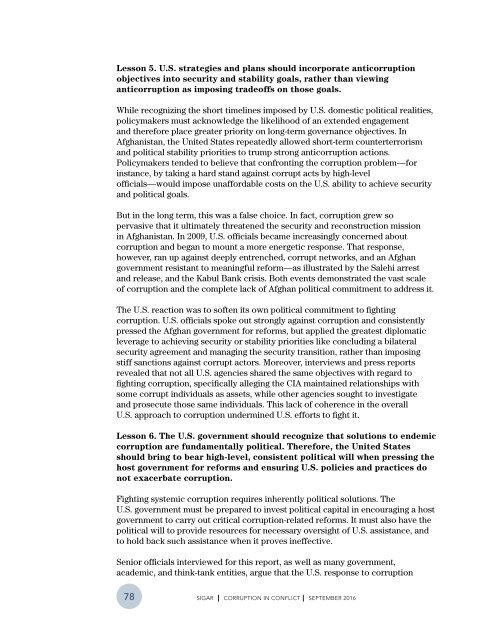CORRUPTION IN CONFLICT
5IlaWjQej
5IlaWjQej
You also want an ePaper? Increase the reach of your titles
YUMPU automatically turns print PDFs into web optimized ePapers that Google loves.
Lesson 5. U.S. strategies and plans should incorporate anticorruption<br />
objectives into security and stability goals, rather than viewing<br />
anticorruption as imposing tradeoffs on those goals.<br />
While recognizing the short timelines imposed by U.S. domestic political realities,<br />
policymakers must acknowledge the likelihood of an extended engagement<br />
and therefore place greater priority on long-term governance objectives. In<br />
Afghanistan, the United States repeatedly allowed short-term counterterrorism<br />
and political stability priorities to trump strong anticorruption actions.<br />
Policymakers tended to believe that confronting the corruption problem—for<br />
instance, by taking a hard stand against corrupt acts by high-level<br />
officials—would impose unaffordable costs on the U.S. ability to achieve security<br />
and political goals.<br />
But in the long term, this was a false choice. In fact, corruption grew so<br />
pervasive that it ultimately threatened the security and reconstruction mission<br />
in Afghanistan. In 2009, U.S. officials became increasingly concerned about<br />
corruption and began to mount a more energetic response. That response,<br />
however, ran up against deeply entrenched, corrupt networks, and an Afghan<br />
government resistant to meaningful reform—as illustrated by the Salehi arrest<br />
and release, and the Kabul Bank crisis. Both events demonstrated the vast scale<br />
of corruption and the complete lack of Afghan political commitment to address it.<br />
The U.S. reaction was to soften its own political commitment to fighting<br />
corruption. U.S. officials spoke out strongly against corruption and consistently<br />
pressed the Afghan government for reforms, but applied the greatest diplomatic<br />
leverage to achieving security or stability priorities like concluding a bilateral<br />
security agreement and managing the security transition, rather than imposing<br />
stiff sanctions against corrupt actors. Moreover, interviews and press reports<br />
revealed that not all U.S. agencies shared the same objectives with regard to<br />
fighting corruption, specifically alleging the CIA maintained relationships with<br />
some corrupt individuals as assets, while other agencies sought to investigate<br />
and prosecute those same individuals. This lack of coherence in the overall<br />
U.S. approach to corruption undermined U.S. efforts to fight it.<br />
Lesson 6. The U.S. government should recognize that solutions to endemic<br />
corruption are fundamentally political. Therefore, the United States<br />
should bring to bear high-level, consistent political will when pressing the<br />
host government for reforms and ensuring U.S. policies and practices do<br />
not exacerbate corruption.<br />
Fighting systemic corruption requires inherently political solutions. The<br />
U.S. government must be prepared to invest political capital in encouraging a host<br />
government to carry out critical corruption-related reforms. It must also have the<br />
political will to provide resources for necessary oversight of U.S. assistance, and<br />
to hold back such assistance when it proves ineffective.<br />
Senior officials interviewed for this report, as well as many government,<br />
academic, and think-tank entities, argue that the U.S. response to corruption<br />
78<br />
SIGAR I <strong>CORRUPTION</strong> <strong>IN</strong> <strong>CONFLICT</strong> I SEPTEMBER 2016


